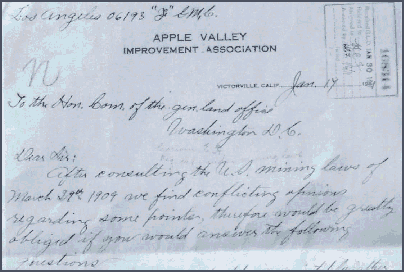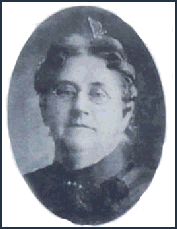
and
The Corwin Ranch

and The Corwin Ranch |

The Apple Valley Improvement Association was an organization made up of the prominent citizens of the community, and was responsible for the adoption of the name "Apple Valley," one of several names that unofficially had been applied to the area during the past.
D. W. McPherson was a leading member of the organization for years, and its roster of prestigious pioneers also included, to name a few, Dr. Harris Garcelon, Arthur E. Hull, W. A. Foster, and F. A. Fletcher. As early as 1910 Elmore was writing letters to the Land Office on the association's letterhead, an indication that he almost immediately had been accepted into the leadership of the community.

McPherson wrote of the association, and of the naming of the valley, in the December 1913 issue of the semi-annual publication, The Kingdom of the Sun:
The territory included in Apple Valley is situated on the east side of the Mojave River, beginning at the base of the San Bernardino. The name was decided upon several years ago when the settlers began to discern the possibilities it held as a fruit growing locality. When the residents (about a dozen men and women) met to organize an improvement association, after careful consideration it was decided to name this section "Apple Valley," and naturally we called our association the "Apple Valley Improvement Association." We then believed, and we now know, that it is an appropriate name: for aside from the numerous ranches that have from ten to one hundred acres in full bearing, there have been over a thousand acres set to apples this spring. |
By coincidence an obituary notice for Mrs. Ursula Poates was published in this same issue of the book. Mrs. Poates arrived in Hesperia in 1891 with her husband and two daughters, and she is credited by many historians, myself included, for naming Apple Valley.
A key to understanding the origins of the name is given in an article appearing in the June 12, 1895, issue of the San Bernardino Daily Times-Index. The story concerns a big new development planned for the east side of the Mojave River. This was a project of the newly-formed Appleton Land and Water Company, and this excerpt from the article explains how the name "Appleton" came to be:
The land to be irrigated lies to the east of Hesperia and Victor, is all surveyed and already has many settlers that have taken up homesteads, going down 125 feet for water, and they have proved the fertility of the soil and its adaptability to fruit raising, especially apples, for which it seems to be well adapted as to quality and quantity. From this fact the name of the company is called Appleton, and the region will become the great apple-bearing belt of this county. |

Appleton Land and Water never did develop the lands east of the river; they became entangled in litigation with other land development companies over the issue of water. Meanwhile Mrs. Poates, now a widow, began dealing in real estate, first with lots in Hesperia, and ultimately switching to acreage on the east Mojave mesa.
In 1904, according to the following news article from the July 19th San Bernardino Daily Times-Index of that year, she laid out plans for her own development, which included the town of Apple, not "Appleville," as it is off-handedly referred to by the reporter, who seems to think the proposal is a scam and laces the story with sarcasm:
Have you heard of "Apple," the new townsite? It is a desert proposition, and is already attracting some little notice from home seekers. Within a few days the promoter of the scheme, a woman, will file with the board of supervisors her map, showing the town lots, proposed site of churches, schoolhouses, Carnegie library, banks, city hall and the like, for it is the intention to make Apple one of the real things in the way of towns. The site is owned by Mrs. Poatz [sic], a Los Angeles woman. It consists of a school section, which she has held title to for many years. In the past the locality has come before the public under other names, but always with the one idea of selling lots to prospective homeseekers, and some few lots have been partly sold, none of the purchasers ever getting beyond the first or second payment, in consequence the title eventually lapsed. But this was no fault of the busy little woman who had to shoulder possession again, and while the land is said to be good for any old crop, it is, it seems, just the right place for raising investors. Some weeks ago Mrs Poatz employed surveyors to replat the land. And maps are now being drawn and blueprinted, showing that Apple is the principal town in "Apple Valley." This valley lies east of Victorville, about twelve miles from the railroad, and is intersected by the main road to Rabbit Springs. It is well known that at the springs development of water has been carried on for months, and is meeting with much success, and as a result acres of government land, heretofore given over to the desert, have been reclaimed, and it is supposed that this fact is what gave the woman the cue to again bring her celebrated school section into prominence, though there is said to be no sign of water on the property, nor any likelihood that water will be developed by the industrious promoter of Appleville. It is reported that Mrs. Poatz has succeeded in locating quite a number of people in the new town, though none have yet taken up their residence there, probably waiting for the improvements which are "bound to come," when their town lots will be transformed into a veritable "golden fleece." It is expected that the maps will be presented to the county supervisors at their next meeting, when some interesting facts concerning the past, present and future of Appleville will be brought to light. |

Later, when asked by her neighbor T. E. Dennison why she chose the name Apple Valley, Mrs. Poates told him that the original name was Appleton Valley. She then went on to say, "There were some apples being raised along the river in those days, but not by the ton, so I just cut it down and called it Apple Valley." Agreeing with her assessment of apple production, one fellow suggested sardonically that since there were a lot more pigs there than apple trees, the name "Squealerville" would be more appropriate.
Ursula Poates' plan for the town of Apple on her property was never realized, but when the improvement association adopted the name of "Apple Valley" for their community, they preserved, if not her dream, at least the name she created for the valley.

 PAGE
1|
2|
3|
4|
5|
6|
7|
8|
9|
10
PAGE
1|
2|
3|
4|
5|
6|
7|
8|
9|
10

